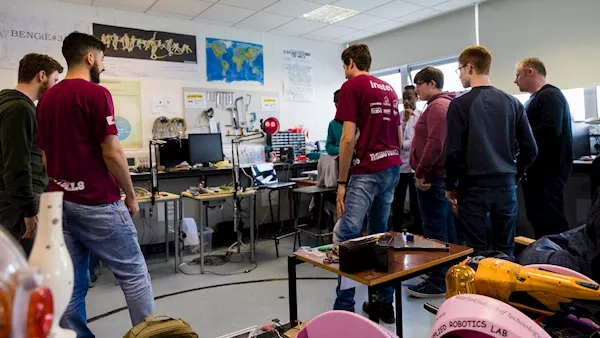Students at Waterford Institute of Technology (WIT) have created a robotic "friend" which uses software to work out how people feel.
Their ‘Lampbot’ uses software to work out how people feel and then respond accordingly with its own body language using movement, eyes and headdress.
The smart home assistant, which combines a robotic arm with a domestic lamp, also uses Google’s latest chatbot technology, such as Alexa or Siri, to help out where it can.
It was developed by Internet of Things and Electronic Engineering students at WIT in the institute’s Applied Robotics Lab under the School of Engineering lecturer Jason Berry who believes that technology means we now consider having conversations with artificially intelligent bots over the internet as normal.
He said: "What if we wanted to bring more than a robotic voice into our home? "hat if we want some movement, maybe even some emotions from our robot?
"One of the most powerful ways for humans to communicate with each other is with eye contact. The students leveraged this human trait in the design of the robot, helping the Lampbot to make more of an emotional connection with its humans."
The “world’s first 6-axis Robotic Lamp Assistant” comes "with the moves to back up the talk", the WIT students said.
Former De La Salle Waterford pupil, Michael Vereker, from Waterford city was part of the two-person team involved in the lamp's movement.
He said: "Actuator motors were attached to the lamp and wired back to motor controllers. Software was written to control the lamp's movement using data sent from Vision Software.
"Everybody had their own part to complete (movement, vision, eyes, speech etc) and when it was all connected at the end the lamp really came to life."
The team's work in the emerging area of social robotics means that they created an assistant that is socially acceptable in a home environment by enabling it to recognise emotions.

Mr Berry said: "Traditionally when people think of robots the Terminator and the arms that build our cars come to mind. We are now in a time where robots are leaving the factories and labs to make their way into our homes.
"However none of these are suitable for a home environment and this is the design challenge facing engineers, scientists and technologists."
Third-year Electronic Engineering student, James Kinsella, from Co. Wexford worked on the robot's head and eye movement and said he enjoyed showcasing the work the most.
He said: "The best part of the project was showing the Lampbots in operation to people not involved in the project."
Robert Solomon, a graduate from WIT's Applied Computing (Internet of things) worked on applying sound detection tracking to the robot, giving it a more human quality.

The team that worked on the project in WIT.
He said: "This means that the robot would be able to detect where a sound source was coming from and be able to face the direction of where it came from, giving it a more human-to-robot feel."
Brian Prendergast from Mullinavat, Co Kilkenny, has just completed the Bachelor of Engineering in Electronic Engineering and was involved in enhancing the robot's facial expressions and its headdress.
He said: "As a bonus, this project was directed towards school going children and I felt that the extra movement attached to the lampbot would entice more interest to the project.
"As a standalone project, the future is bright, as many applications can be added to enhance the project further which could be beneficial to the general public and children with sensory processing disorders, etc."






